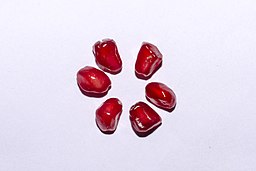Anardana
| Pomegranate | |
|---|---|
 |
|
| Fruit of Punica granatum split open to reveal the clusters of juicy, gem-like seeds on the inside. | |
| Scientific classification | |
| Kingdom: | Plantae |
| Clade: | Angiosperms |
| Clade: | Eudicots |
| Clade: | Rosids |
| Order: | Myrtales |
| Family: | Lythraceae |
| Genus: | Punica |
| Species: | P. granatum |
| Binomial name | |
|
Punica granatum L. |
|
| Synonyms | |
|
|
| Nutritional value per 100 g (3.5 oz) | |
|---|---|
| Energy | 346 kJ (83 kcal) |
|
18.7 g
|
|
| Sugars | 13.67 g |
| Dietary fiber | 4 g |
|
1.17 g
|
|
|
1.67 g
|
|
| Vitamins | |
| Thiamine (B1) |
(6%)
0.067 mg |
| Riboflavin (B2) |
(4%)
0.053 mg |
| Niacin (B3) |
(2%)
0.293 mg |
| Pantothenic acid (B5) |
(8%)
0.377 mg |
| Vitamin B6 |
(6%)
0.075 mg |
| Folate (B9) |
(10%)
38 μg |
| Choline |
(2%)
7.6 mg |
| Vitamin C |
(12%)
10.2 mg |
| Vitamin E |
(4%)
0.6 mg |
| Vitamin K |
(16%)
16.4 μg |
| Minerals | |
| Calcium |
(1%)
10 mg |
| Iron |
(2%)
0.3 mg |
| Magnesium |
(3%)
12 mg |
| Manganese |
(6%)
0.119 mg |
| Phosphorus |
(5%)
36 mg |
| Potassium |
(5%)
236 mg |
| Sodium |
(0%)
3 mg |
| Zinc |
(4%)
0.35 mg |
|
|
|
|
|
| Percentages are roughly approximated using US recommendations for adults. Source: USDA Nutrient Database |
|
The pomegranate (Punica granatum) is a fruit-bearing deciduous shrub or small tree in the family Lythraceae that grows between 5 and 8 m (16 and 26 ft) tall.
The fruit is typically in season in the Northern Hemisphere from September to February, and in the Southern Hemisphere from March to May. As intact arils or juice, pomegranates are used in baking, cooking, juice blends, meal garnishes, smoothies, and alcoholic beverages, such as cocktails and wine.
The pomegranate originated in the region extending from modern-day Iran through Afghanistan and Pakistan to northern India, and has been cultivated since ancient times throughout the Mediterranean region. It was introduced into Spanish America in the late 16th century and into California by Spanish settlers in 1769.
Today, it is widely cultivated throughout the Middle East and Caucasus region, north and tropical Africa, South Asia, Central Asia, the drier parts of southeast Asia, and parts of the Mediterranean Basin. It is also cultivated in parts of Arizona and California. In the 20th and 21st centuries, it has become more common in the shops and markets of Europe and the Western Hemisphere.
...
Wikipedia

